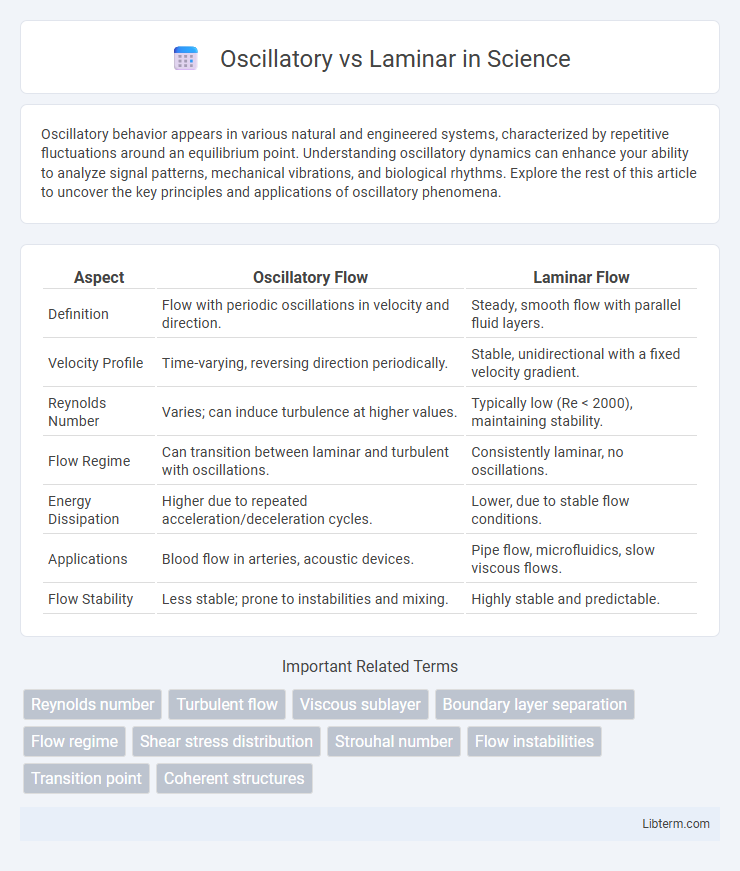Oscillatory behavior appears in various natural and engineered systems, characterized by repetitive fluctuations around an equilibrium point. Understanding oscillatory dynamics can enhance your ability to analyze signal patterns, mechanical vibrations, and biological rhythms. Explore the rest of this article to uncover the key principles and applications of oscillatory phenomena.
Table of Comparison
| Aspect | Oscillatory Flow | Laminar Flow |
|---|---|---|
| Definition | Flow with periodic oscillations in velocity and direction. | Steady, smooth flow with parallel fluid layers. |
| Velocity Profile | Time-varying, reversing direction periodically. | Stable, unidirectional with a fixed velocity gradient. |
| Reynolds Number | Varies; can induce turbulence at higher values. | Typically low (Re < 2000), maintaining stability. |
| Flow Regime | Can transition between laminar and turbulent with oscillations. | Consistently laminar, no oscillations. |
| Energy Dissipation | Higher due to repeated acceleration/deceleration cycles. | Lower, due to stable flow conditions. |
| Applications | Blood flow in arteries, acoustic devices. | Pipe flow, microfluidics, slow viscous flows. |
| Flow Stability | Less stable; prone to instabilities and mixing. | Highly stable and predictable. |
Introduction to Oscillatory and Laminar Flow
Oscillatory flow features fluid particles that move back and forth in a periodic manner, often observed in environments like tidal currents and respiratory airflow. Laminar flow, characterized by smooth, parallel layers of fluid with minimal mixing, occurs at low Reynolds numbers and is common in controlled pipeline systems. Understanding the distinct velocity profiles and Reynolds number thresholds is crucial for optimizing fluid dynamics in engineering and environmental applications.
Fundamental Concepts: What is Laminar Flow?
Laminar flow refers to a smooth, orderly movement of fluid in parallel layers with minimal mixing and velocity variations between layers. This type of flow occurs at low Reynolds numbers, where viscous forces dominate over inertial forces, resulting in steady and predictable fluid behavior. Understanding laminar flow is essential for applications requiring precise fluid control and minimal turbulence, such as in microfluidics and blood flow analysis.
Defining Oscillatory Flow: Key Characteristics
Oscillatory flow is characterized by the periodic reversal of flow direction, typically observed in tidal or pulsatile systems, causing fluid particles to move back and forth without net transport over a cycle. It exhibits high-frequency velocity fluctuations and shear stress oscillations, contrasting with the steady, unidirectional velocity profile of laminar flow. Key parameters defining oscillatory flow include the Strouhal number and dimensionless Womersley number, which influence the flow's velocity distribution and boundary layer development.
Differences Between Oscillatory and Laminar Flow
Oscillatory flow features a back-and-forth motion characterized by periodic velocity changes, causing fluid particles to move in reversing directions, whereas laminar flow involves steady, unidirectional movement of fluid layers sliding smoothly past each other without disruption. Oscillatory flow commonly occurs in tidal environments and respiratory systems, generating complex shear stresses, while laminar flow is typically observed in narrow pipes or slow-moving fluids, promoting stable velocity profiles and predictable transport. The key difference lies in the flow patterns and velocity variations, with oscillatory flow exhibiting dynamic, cyclical fluctuations compared to the constant, orderly nature of laminar flow.
Factors Influencing the Transition Between Flow Types
The transition between oscillatory and laminar flow is influenced primarily by factors such as Reynolds number, fluid velocity, and surface roughness. Lower Reynolds numbers and smooth surfaces typically promote laminar flow, whereas higher velocities and increased surface irregularities encourage oscillatory or turbulent patterns. Temperature and fluid viscosity also play crucial roles by altering flow stability and resistance.
Real-World Applications of Laminar Flow
Laminar flow, characterized by smooth and orderly fluid motion, is crucial in medical applications such as precise drug delivery through intravenous systems and maintaining sterile environments in operating rooms. It enhances efficiency in aerospace engineering by reducing drag over aircraft wings, thus improving fuel economy and performance. In industrial processes like semiconductor manufacturing, laminar flow ensures contamination-free environments critical for high-quality production.
Practical Uses of Oscillatory Flow in Engineering
Oscillatory flow, characterized by periodic reverse movement of fluid, finds extensive practical use in engineering applications such as heat exchangers, where enhanced thermal mixing improves efficiency. This flow regime is critical in biological systems mimicking blood flow in biomedical devices, and in chemical reactors, oscillatory flow promotes superior mass transfer and reaction rates compared to laminar flow. Engineers leverage oscillatory flow to optimize mixing without increasing turbulence, reducing energy consumption and wear on components in various industrial processes.
Impact on Heat and Mass Transfer
Oscillatory flow enhances heat and mass transfer rates by disrupting boundary layers and inducing mixing, which increases the convective transport efficiency compared to laminar flow. Laminar flow, characterized by smooth and orderly fluid motion, typically exhibits lower heat and mass transfer coefficients due to limited mixing and dominant molecular diffusion. In applications like heat exchangers and chemical reactors, leveraging oscillatory flow patterns significantly improves thermal and mass transfer performance, leading to higher process effectiveness and energy efficiency.
Challenges and Limitations of Each Flow Type
Oscillatory flow presents challenges in accurately predicting turbulent transitions due to its time-dependent velocity fluctuations, which complicate modeling and computational simulations. Laminar flow, while easier to predict and control, is limited by low Reynolds numbers and is prone to instability under increased flow rates, restricting its applicability in high-performance systems. Both flow types require advanced experimental techniques or numerical approaches to overcome limitations related to flow separation, mixing efficiency, and energy losses.
Conclusion: Choosing Between Oscillatory and Laminar Flow
Choosing between oscillatory and laminar flow depends on the specific application requirements and fluid dynamics involved. Oscillatory flow enhances mixing and heat transfer in systems like respiratory devices, while laminar flow provides steady, predictable fluid movement ideal for chemical processing and microfluidics. Evaluating factors such as flow stability, energy efficiency, and target outcomes guides the optimal selection for engineering and biomedical applications.
Oscillatory Infographic

 libterm.com
libterm.com